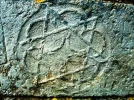sillydoll
Veteran Member
- Time of past OR future Camino
- 2002 CF: 2004 from Paris: 2006 VF: 2007 CF: 2009 Aragones, Ingles, Finisterre: 2011 X 2 on CF: 2013 'Caracoles': 2014 CF and Ingles 'Caracoles":2015 Logrono-Burgos (Hospitalero San Anton): 2016 La Douay to Aosta/San Gimignano to Rome:
Last year I took many photographs of mason's signs on monuments along the camino frances. This one on the wall of the church at Roncesvalles dates from the earlier hospice building (early 13th-c) which was recycled to build the new church.
This explanation from the nexusjournal.com
This explanation from the nexusjournal.com
We now know the imposed equilateral triangles as the Star of David, and as the result is a hexagon. This is traditionally related to the Six Days of Creation, the Hexaemeron, and thus refers to the Authorship of the Cosmos -- God.
Concentric with the Star, is a floriated circle with six 'petals', the inner circle being omitted. This expansive figure can be related to light-geometry, as light expands as a circle, and the six 'petals' can be understood to refer to subsidiary light sources, such as planets or stars. Such a figure is common in High Gothic stained glass windows, and even the combination of circular geometry with the rectilinear Star can be related to the straight armatures needed to strengthen the otherwise curvilinear geometry of such windows, especially at the head or top of the window. So the mason may have been especially concerned with the tracery common in elaborate windows of the Gothic.
In the centre is a cross formed by quadrants of a circle -- the same circle as the 'petals'? This of course signifies Christ.
The full figure then represents (a) the Process of Creation (b) the resulting Cosmos, and (c) the presence of Christ who will by His Second Coming terminate the Cosmos.
The real mystery is why such a scheme, its complexity better suited to treatment in stained glass, be carved in such an incidental way on a piece of stone. I suggest that it may be a 'masterpiece',
i. e. a work executed - probably to a given theme - thus explaining the relatively complex geometry by an apprentice before his full membership of the mason's guild.










